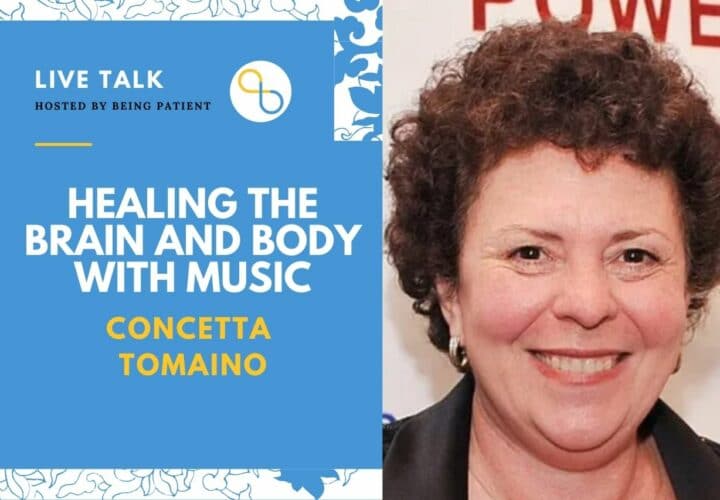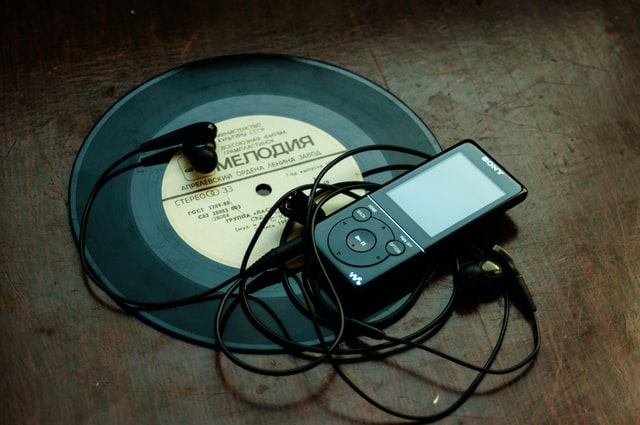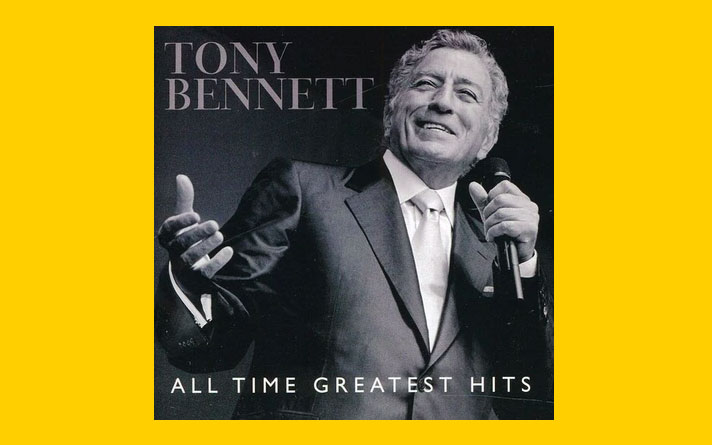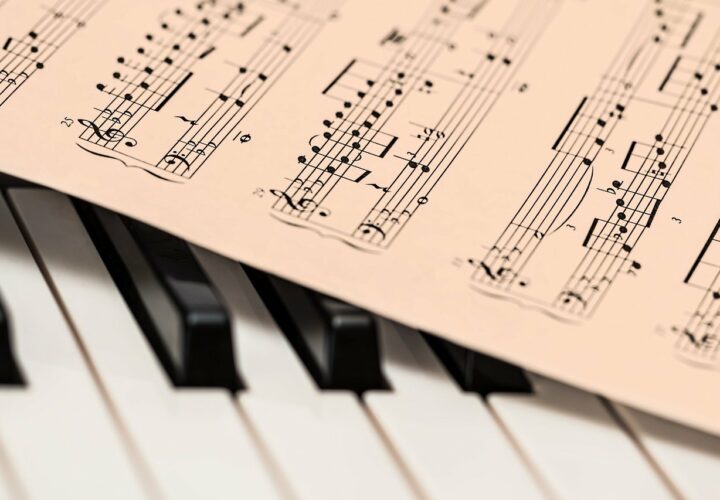Concetta Tomaino, a pioneer in the field music therapy, shares insights on music's therapeutic effects for neurological conditions like Alzheimer's.
As science continues to uncover the wonders of music for the mind and body, music therapy is increasingly recognized by the medical community as a way to preserve or improve the wellbeing of people living with neurodegeneration.
Neurodegenerative diseases like Alzheimer’s often mean losing access to certain kinds of memories. But research compounds myriad personal experiences to show that music — and in particular, songs that hold special meaning to an individual — can serve as a window to their memories. It can also help stimulate cognitive functions like speech and even emotional connection.
In a Being Patient LiveTalk, Concetta Tomaino, a pioneer in the music therapy field who currently serves as executive director (and co-founder) of the Institute for Music and Neurologic Function (IMNF) and board member of Music & Memory, shares insights on the science behind the benefits of music for neurological conditions, the ins and outs of music therapy, and her expert advice for incorporating music in daily caregiving. She also reflects on her time collaborating with neurologist and author Oliver Sacks.
Being Patient: How did you first get into the field of music therapy?
Concetta Tomaino: In college, I was a pre-med student, and had always been involved in sciences but also studied music. I played accordion when I was a kid and played trumpet in high school. When I was in college, I ended up being a double major in music performance and sciences … Toward the end of my studies in college, I found out about the field of music therapy, which was established in the United States in the ’50s.
I was in college in the ’70s, and there still weren’t that many academic programs [for music therapy]. The graduate degree in music therapy just started at NYU (New York University), so I ended up doing my masters and then later my doctorate at NYU.
One of my first clinical placements in the mid ’70s was in a nursing home. That’s when I had my first experience with people who had suffered strokes, who could somehow move better to music than they could in physical therapy. [There were] people with aphasia related to their stroke that could actually sing words and speak after singing, better than they could in traditional speech therapy. There were people with end-stages of dementia who were seemingly non-responsive and didn’t recognize anything about the environment or the people around them, and yet, when I sang a familiar song, they not only came to life in the moment, but were able to sing the words.
I [thought], ‘How could they possibly do that if their brain is so damaged and their memory is so impaired? What makes music so resilient in people’s minds that they can recall words perfectly even though they can’t say who they are?’ That started my journey in the mid 70s to find out about music and the brain.
Being Patient: You began collaborating with the late neurologist Oliver Sacks and eventually co-founded IMNF with him. Can you tell us how your partnership with Sacks first started?
Concetta Tomaino: In 1980, I had the chance to start to work with Dr. Oliver Sacks at Beth Abraham when I became a full-time music therapist there after my graduation.
He was the staff neurologist at the facility. In fact, that was the facility where Awakenings had taken place, a book that he had written, and eventually a film about that experience came out.
His experience with music was in witnessing people who were immobile because of a post-encephalitic type of Parkinson’s, [people] who could come to life and gain physical function when music was played, even though they couldn’t move on their own volition.
I had already had experience with people with stroke and end-stages of Alzheimer’s disease. I found out that he was very interested in music and had witnessed the influences of music therapy first-hand. Within the first month that I was at Beth Abraham, he sought me out and we connected.
For 35 years, we worked together to explore, explain and understand the dynamics of music and human function. What is it about music that is so embedded in who we are as individuals, and how can we use that in reaching people, helping them have the fullest life possible?
“What is it about music that is so embedded in
who we are as individuals, and how can we use that
in reaching people, helping them have the fullest life possible?”
Being Patient: Currently, what do we know about the effects of music on the brains of people living with Alzheimer’s?
Concetta Tomaino: It’s such a dynamic process, and scientists are still trying to identify all the different elements that are affected when we hear and interact with music.
There [are] some things we know already. For example, the auditory system has networks throughout the brain that are aroused and stimulated by patterns of sound. Those patterns of sound can actually stimulate motor function and attention.
We also know that we respond emotionally to certain types of sounds. The music that we love, that we form attachments for and hold memories of, become deeply embedded in subcortical networks in our brain. They are still very well preserved, so those emotional connections to a song that we love remain with us for quite a long time, up until the very end.
“The music that we love, that we form attachments
for and hold memories of, become deeply
embedded in subcortical networks in our brain.”
When you think about music, you think about vibrations in the air. You think about the tone [and] pitch of the music. You think about the notes coming together in harmony and the patterns of sound. It’s very complex, and to really understand exactly how each one of those things affect us neurologically is complex as well.
There [are] studies that look at the psychodynamic aspects of music interaction. They give us some answers about the importance of personalized music and interaction [from a psychological point of view]. Then, there [are] some neuroscience studies that show us what happens in the brain when somebody responds to rhythm, or what parts of the brain light up when a familiar song is heard. We’re starting to get glimpses of some of those impacts. And of course, there [are] more advanced studies that help us explain [those interactions] and provide some efficacy for the importance of music as a therapy.
Being Patient: So music has the ability to activate many different aspects of our brain functions.
Concetta Tomaino: Music is so much more resilient and well preserved than say, a visual cue. Visual perception is a higher cortical function, and music allows some of [the] deeper, lower parts of the brain networks that are more robust and resilient, that are still very much functional, [to] be stimulated even if the person can’t recognize the song by name and they’ve lost those aspects of cognition.
The sense of knowing is still very strong, and the emotional connections is still very strong. That’s one of the benefits of using personalized familiar music with people with neurocognitive deficits like Alzheimer’s disease, because it allows us to reach those areas that are still functional and very well preserved.
Being Patient: What does music therapy entail for people living with Alzheimer’s?
Concetta Tomaino: It’s really quite broad. It depends on the individual. In the early stages, say somebody has just been diagnosed with neurocognitive deficits like Alzheimer’s, and they’re starting to become forgetful, we may not use familiar songs with that person in the beginning. We may find ways of allowing them to be creative and expressive. Maybe write songs, put together lyrics and help them express themselves, and in doing so, build upon some short-term memory skills [and the ability to pair] information.
For example, we may have them find songs that they could connect with loved ones. When they can’t recognize the person anymore, that song has already been associated with that person. If that person visits, singing that song together will help the person with dementia recognize [their loved one]. [We may use] music [as] a mnemonic tool, creating a little melody or rhythmic pattern to help somebody recall and memorize their phone number or address.
As the person loses the ability to recognize loved ones, they’re still able to express themselves. We may do a lot of improvisation, even in the early stages. We may use percussion instruments. We may use melodic instruments, like a keyboard and allow them to explore the sounds and create the soundscape with them.
The main thing is to allow the individual to be as expressive as they can, and to see how it allows them to deal with emotional or memory issues.
When the person starts losing physical function, balance and coordination, there [are] ways of using rhythmic patterns and rhythmic queing of gait to help with balance, coordination and ability to move with more confidence.
Then, we work with care partners, family members, or staff of a facility to create the person’s personalized music playlists to help them connect when a music therapist isn’t there. We may find music that can help the person relax if they get agitated. The person may be restless [at] certain times of the day, so [we may find] music that can help them feel safe, comfortable and calm.
Being Patient: How can music therapy play a role in the end-stage of Alzheimer’s?
Concetta Tomaino: Even in the very, very late stages, people still respond as long as they still are able to hear the melody. We may even improvise sounds if the person is making sounds. We may use that as a way of acknowledging them and bringing them into a musical experience.
The only time music doesn’t work is when people are diagnosed with frontotemporal dementia, sometimes the area of the brain that perceives the actual pitch of music is damaged, so the person only hears noise. That can be very uncomfortable and disconcerting for a person. If somebody wants to try music with their loved one, and sees that the person is pulling away, it could be that [their loved one doesn’t] hear the music itself. It’s noise.
Because music is so personal to us, and because it holds so many deep memories, there could be music that makes us feel wonderful, but there’s also music that can make us feel very sad. One of the things that music therapists are trained to do is even if the music makes the person feel sad, [music therapists] allow them to express those feelings in a way that’s meaningful. But to a caregiver that maybe doesn’t understand what’s going on, we usually suggest [avoiding] songs that may be too difficult for the person to listen to emotionally.
Being Patient: IMNF, Certification Board for Music Therapists, American Music Therapy Association and Music & Memory are all helpful resources for people. What are other ways families and their loved ones can learn about music programs or seek music therapy?
Concetta Tomaino: Depending on what state people live in, music therapy is reimbursable through some insurance companies. Many times, it’s referred by a physician or a case manager that they’re working with.
The referral to music therapy could be for a range of potential goals. It could be for behavioral issues [and] for psychodynamic type [of] work. It [could] … support physical and speech therapy. It’s not to replace those therapies, but to support some of those goals. Even [for] people with frontotemporal dementia, there may be ways that sound and other types of things can help with some of the behaviors.
Being Patient: How about group-based music programs?
Concetta Tomaino: There [are] wonderful group-based programs. There [are] percussion programs all over the country. In several areas, there [are] choirs for people who have memory issues and their partners. They should look and see if there’s a choir in the neighborhood that they could participate in. Those are very successful.
Being Patient: Outside of music therapy, how can people incorporate music into their own lives?
Concetta Tomaino: There are so many music videos online that people can gain access to. Whatever the music that you like to listen to, you should spend some time together each day to listen [to the music]. Maybe sing some of the songs. If you like to dance, put on some music. Being mobile actually helps with balance and coordination. If there’s [an] upbeat song that you can play to do some exercise and movement, that’s really great.
There are resources online. We (IMNF) have a Facebook live program on Tuesday mornings, but other music organizations like Lincoln Center in New York offer some programs online geared for people with memory issues.
Being Patient: Do you have any last thoughts that you’d like to add?
Concetta Tomaino: People should really look to see if music therapy is available to them and in their city, and to take advantage of bringing music into their life. I’m hoping that it is a part of everybody’s life, but find ways of using it with their loved ones, and to make it a family affair so they can maintain those relationships as long as possible at a very strong level.
The interview has been edited for length and clarity.




This is an excellent summary of music with dementia and I’m so grateful for her outstanding contributions. I would like to add the other resource I am most familiar with, that of respite care programs that all feature some kind of musical involvement, usually singalongs. As a retired psychologist and still very active musician, especially with respite singalongs, I can tell you that these programs provide a social connection and engagement, memory stimulation and new learning opportunity, venue for expression and affirmation of personhood, and sharing of love and joy that is sometimes astounding and always magical.